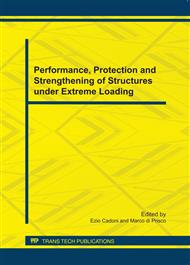p.326
p.332
p.338
p.344
p.350
p.356
p.362
p.368
p.374
Importance of Time-Dependent Material Behavior in Predicting Strength of Steel Columns Exposed to Fire
Abstract:
One of the critical factors affecting the strength of steel columns at elevated temperatures is the influence of material creep. Under fire conditions, steel columns can exhibit creep buckling, a phenomenon in which the critical buckling load for a column depends not only on slenderness and temperature, but also on the duration of the applied load. This paper will propose a preliminary methodology to study the phenomenon of creep buckling in steel columns subjected to fire. Analytical solutions using the concept of time-dependent tangent modulus are developed to model time-dependent buckling behavior of steel columns at elevated temperatures. Results from computational creep buckling studies using ABAQUS® are also presented, and compared with analytical predictions. Both analytical and computational methods utilize material creep models for structural steel developed by Harmathy, and by Fields and Fields. The analytical and computational results clearly indicate that accurate knowledge of material creep is essential in studying creep buckling phenomenon at elevated temperatures, and that neglecting creep effects can lead to potentially unsafe predictions of the strength of steel columns subjected to fire.
Info:
Periodical:
Pages:
350-355
Citation:
Online since:
July 2011
Keywords:
Price:
Сopyright:
© 2011 Trans Tech Publications Ltd. All Rights Reserved
Share:
Citation:


